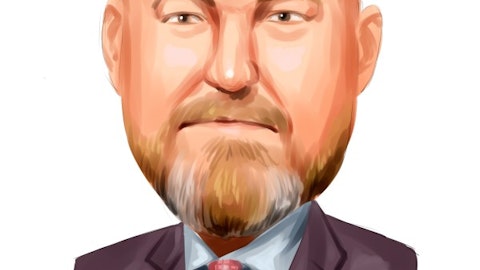Michael Casey: Sure. So heading into next year, we have visibility to wholesale demand for our spring and summer 2024 product offerings given the good work our supply chain team has done working with our merchants and designers, the product costs are expected to be lower going into the first half of next year. And so because the product costs are lower, the pricing will be for those early deliveries for spring and summer 2024 the pricing will be comparable to lower. So we are expecting margin expansion. So again, we see some opportunities on some key item price points to test lower pricing. We see less need for increasing prices given the progress that we’ve made on ocean freight rates and product costs going into next year. And again, our comps in the third quarter were down 10% and right now in October, running down about 16%.
Irwin Boruchow: Great. And last question maybe for Richard. I think you talked about SG&A down in 4Q. You guys have really been tight on expenses. Is there any initial thoughts on SG&A into next year? Should we continue to expect you guys to really keep that SG&A tight? And just kind of curious if there’s any initial views you can kind of give us on the expense line? Thank you, guys.
Richard Westenberger: Yes, Ike. I would say we continue, to Mike’s point, be managing for profitability, margin preservation and cash flow. Those are the things that we have with the most control over in this kind of environment. We’ve done a lot of very good work looking at our cost structure of the organization. I’m really pleased with how they responded to the challenge. Everybody understands the environment that we’re in. And the best thing we can do is just keep ourselves as lean as possible. As you saw in the press release this morning, we did take some charges related to organizational restructuring. That has lowered our staffing costs. There’s other things that we’ve been looking at and making good progress on indirect procurement.
We’ve been focused on marketing effectiveness. So our focus will remain on SG&A, keeping it as low as possible. I think it’s too early to be specific on next year’s plans, but you can be assured that it’s an ongoing discipline and an area of focus for us, and we’ve made good progress in managing it this year.
Irwin Boruchow: Great. Thank you, guys.
Richard Westenberger: Sure.
Operator: Thank you. [Operator Instructions] Our next question will come from the line of Jim Chartier of Monness, Crespi, Hardt. Your line is open.
Jim Chartier: Good morning. Thanks for taking my question. Just wanted to talk about product costs. Given kind of the big reduction in cotton over the last 12-plus months. I would have expected maybe some of that to flow through into lower product costs in the back half of this year. So I was hoping if you could talk about what some of the offsets to the lower cotton costs were for the back half of this year. And then maybe what some of those factors look like for spring of next year and fall of 2024? Thanks.
Richard Westenberger: So Jim, I would say we are starting to see the benefit of lower cotton and other input costs in our product costs. I think that leads into the P&L kind of over time, you receive that product. It goes into inventory and then you realize some of that margin upside when you sell the product. Recall that we’re still working through that pack and hold inventory that was procured at a time when product costs were elevated. Where we are seeing a tremendous benefit on is in these inbound transportation costs. That’s been a big source that gets inventoried into the cost of the inventory as well. So we’re expecting good favorability from that here in the fourth quarter. That is a benefit that will continue through the first half of next year as well.
Once we get to midyear next year, we’re more or less kind of anniversarying those lower rates that have benefited the second half of this year. But we are planning for lower product costs in the first half of the year. I think the biggest determinant of that even beyond cotton is just worldwide capacity. The global marketplace has meaningfully slowed down. And we have terrific teams here in Atlanta and in Hong Kong to work with our factories. We’ve had a series of meetings, top-to-top meetings with our largest vendors recently. And they’re hungry. They love doing business with Carter’s, we’ve been a source of great growth over the years, a good partner for them as well, and they are hungry for business. And so I think that available worldwide capacity is the bigger determinant.
Cotton certainly is a benefit to us, but we’re seeing good capacity across Asia, and we think that will drive even first half of next year. We don’t have complete visibility to the second half of the year, yes. Hopefully, we’ll have more of that to share with you on the next call.
Jim Chartier: Great. Thank you.
Richard Westenberger: Sure.
Operator: Thank you. [Operator Instructions] And our next question will come from Jay Sole of UBS. Your line is open.
Jay Sole: Great. Thank you so much. Maybe, Mike, I just want to follow up on the Wholesale business. I think you touched on this, but can you elaborate a little bit more on how the sell-through is at your big wholesale customers? I mean, how do you see the product, how do you see the sales moving in like Amazon Prime Day, for example, in October, like how did you see that event for the company? If you can tell us a little bit more detail on that, that would be super helpful.
Brian Lynch: Yes, Jay, the sell-throughs have been good in Wholesale. I’d say fall is better than last year. Now higher AURs, as Mike talked about, a good margins for the retailers. And I recall, they did buy seasonal lower. But sell-throughs have been good. Their inventory is in good shape. We commented on the supply chain is doing a heck of a job this year. We’re near 100% on time. So we’ve got a meaningfully fewer cancelled plans. So they’re faring well, I would say, particularly the top three are doing really well. We did have some orders move into Q3 from Q4, but we seem to have good momentum in the business. So I would say the outlook is positive. Our relationship with Amazon is good. Prime Day, we exceeded their expectations, but we look at it for on an annualized basis, and we feel good about our overall Amazon business.




